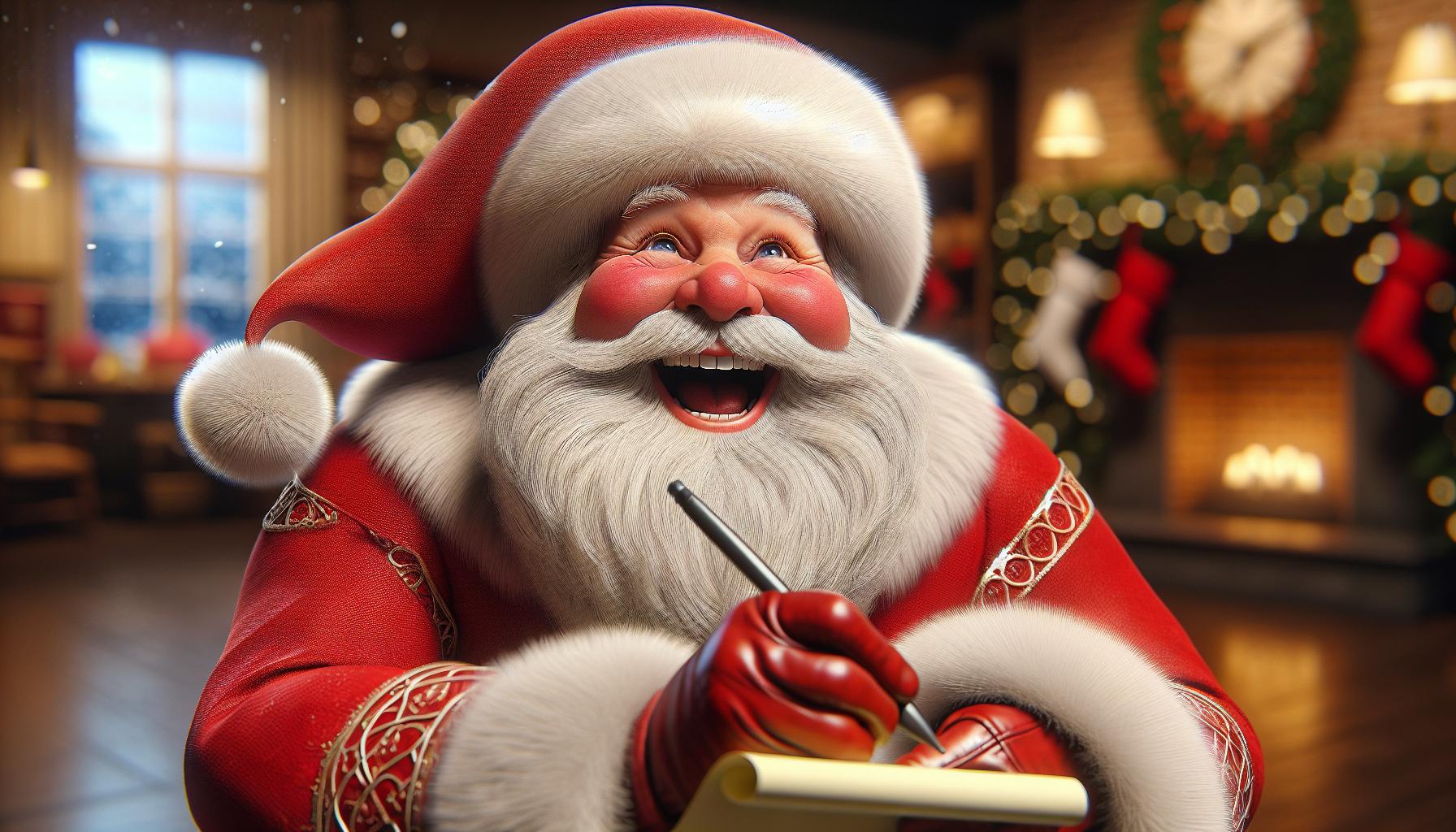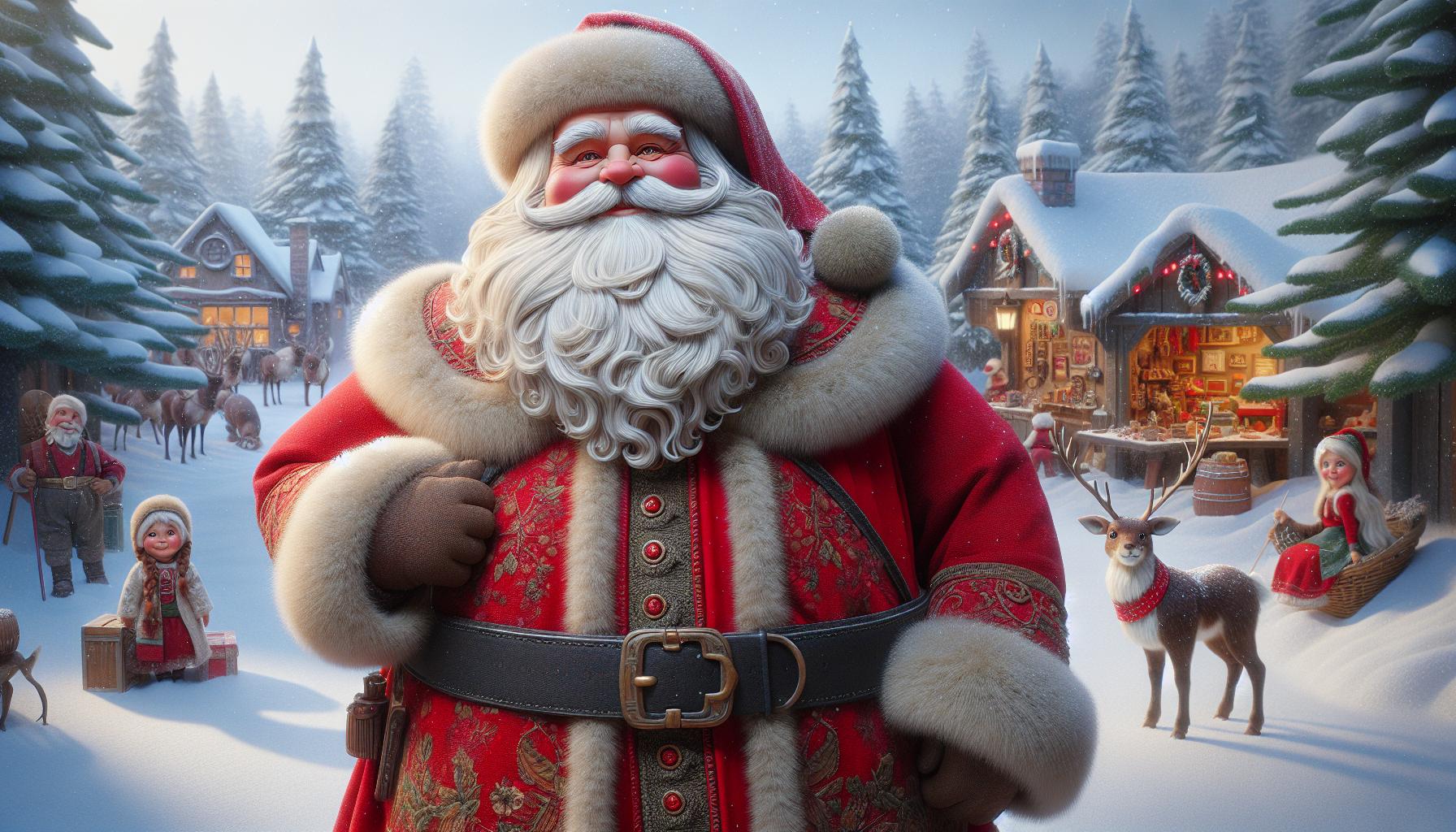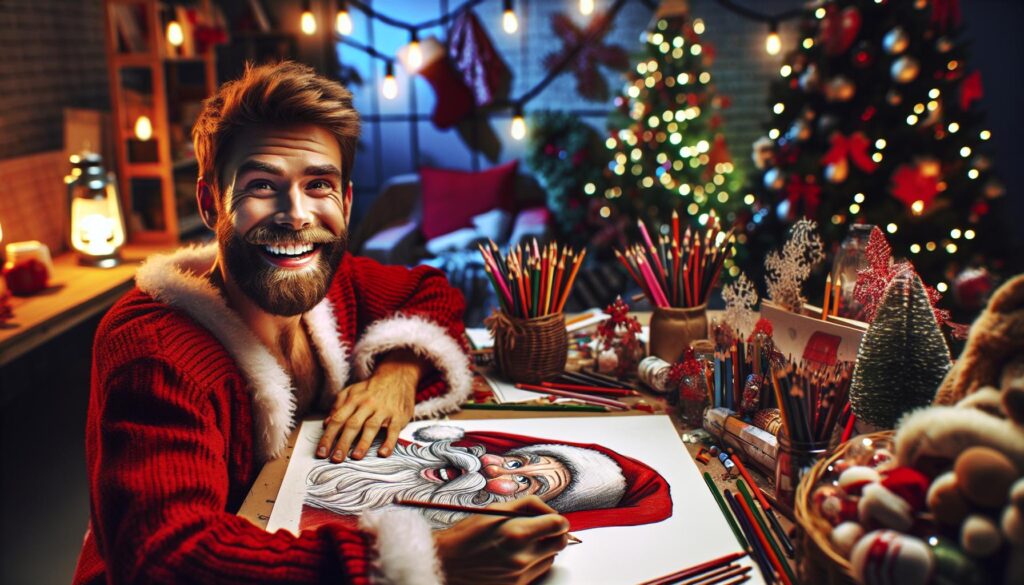As the holiday season approaches, I find myself drawn to the iconic figure of Santa Claus. There’s something magical about capturing his jolly spirit through art. Whether you’re a seasoned artist or a beginner, drawing Santa can be a fun and festive way to embrace the Christmas spirit.
Key Takeaways
- Santa’s appearance evolved from St. Nicholas to the modern jolly figure through various artistic interpretations
- Essential elements for drawing Santa include his red suit, white trim, rosy cheeks, and full white beard
- Basic sketching techniques and adding details are crucial for creating a recognizable Santa illustration
- Popular Santa drawing styles range from traditional realistic portrayals to modern cartoonish interpretations
- Incorporating Santa into festive scenes enhances the magical atmosphere of winter landscapes
- Digital tools and software offer versatile options for creating stunning Santa artwork with enhanced features
Drawing:epqmli39czy= Santa
The iconic figure of Santa Claus has evolved over centuries, with his image shaped by various cultural influences and artistic interpretations. I’ll explore the historical roots of Santa’s depiction in art and how his appearance has changed over time.
Historical Depictions of St. Nicholas
St. Nicholas, the 4th-century Christian bishop, serves as the primary inspiration for Santa Claus. Early artistic representations of St. Nicholas typically portrayed him as a thin, bearded man wearing bishop’s robes and holding a crosier. These images appeared in Byzantine icons, medieval frescoes, and illuminated manuscripts. Notable examples include:
- The 13th-century fresco in the Basilica di San Nicola in Bari, Italy
- The 14th-century icon of St. Nicholas at the Tretyakov Gallery in Moscow
- The 15th-century altarpiece by Fra Angelico at the Vatican Museums
St. Nicholas was often depicted performing miracles or giving gifts to the poor, establishing his association with generosity and gift-giving.
Evolution of Santa’s Appearance
Santa’s modern appearance emerged gradually through various artistic interpretations:
- 16th-17th centuries: Dutch Sinterklaas illustrations showed a tall, thin figure with a long white beard
- 1823: Clement Clarke Moore’s poem “A Visit from St. Nicholas” described Santa as plump and jolly
- 1863: Thomas Nast’s illustrations for Harper’s Weekly solidified Santa’s round figure and red suit
- 1931: Haddon Sundblom’s Coca-Cola advertisements popularized the warm, grandfatherly Santa we know today
Key elements of Santa’s evolving appearance:
| Time Period | Characteristic Features |
|---|---|
| Pre-19th century | Thin, austere, bishop’s robes |
| Early 19th century | Plump, jolly, fur-trimmed coat |
| Late 19th century | Red suit, black boots, white beard |
| 20th century | Rosy cheeks, glasses, belt with buckle |
Artists like N.C. Wyeth, Norman Rockwell, and J.C. Leyendecker contributed to refining Santa’s image in the 20th century, creating enduring representations that continue to influence how we draw Santa today.
Iconic Elements of Santa Drawings

When drawing Santa Claus, certain iconic elements are essential to capture his recognizable and beloved image. These classic features help bring the jolly old elf to life on paper, instantly evoking the magic of Christmas.
The Red Suit and White Trim
Santa’s red suit with white trim is a defining characteristic of his appearance. I always start with a bright red base for the coat and pants, adding white fur trim along the edges. The wide black belt cinched around Santa’s ample waistline is another crucial detail, often adorned with a large, golden buckle. To complete the outfit, I include black boots and matching gloves, which contrast nicely with the red suit and white fur.
Santa’s Facial Features and Expression
Capturing Santa’s facial features and expression is key to conveying his warm, friendly persona. I focus on his rosy cheeks, twinkling eyes, and gentle smile to bring out his jovial nature. Santa’s signature white beard is full and fluffy, often covering much of his face and blending into his hair. His eyebrows are typically bushy and white, arching expressively above kind eyes that crinkle at the corners. A round, red nose adds a touch of whimsy to his face, completing the iconic look that has enchanted generations of children and adults alike.
Techniques for Drawing Santa

Drawing Santa requires specific techniques to capture his iconic appearance. I’ll outline key methods to bring the jolly old elf to life on paper.
Sketching the Basic Shape
I start with simple geometric shapes to form Santa’s basic structure. A large circle for the head, an oval for the body, and smaller circles for hands and feet create the foundation. I add a triangular hat and rectangular belt to establish Santa’s silhouette. Proportions are crucial; I make the body about 2-3 head lengths tall for a stocky, jolly appearance. Light, loose pencil strokes allow for easy adjustments as I refine the sketch.
Adding Details and Texture
Once the basic shape is established, I focus on adding details and texture to bring Santa to life. For his face, I draw a curved line for the mustache, connecting it to the beard, which I render with wavy lines to suggest fluffiness. I add wrinkles around the eyes and mouth to convey warmth and age. For the suit, I use short, curved strokes to indicate folds and texture in the fabric, particularly around the elbows, knees, and belly. I pay special attention to the fur trim, using small, repetitive strokes to create a soft, fuzzy appearance. The belt buckle gets extra detail with a simple square shape and minimal shading. For Santa’s boots, I add shine with strategically placed highlights and shadows.
Popular Santa Drawing Styles

Santa Claus’s image has evolved over time, leading to various popular drawing styles. These styles range from classic interpretations to more contemporary takes, each capturing the essence of the beloved holiday figure in unique ways.
Traditional Illustrations
Traditional Santa illustrations often feature a realistic, warm, and inviting portrayal. These drawings typically depict Santa with a full, white beard, rosy cheeks, and twinkling eyes. His red suit is usually richly detailed, with fur trim and a wide black belt. Traditional styles often incorporate elements like Santa’s workshop, reindeer, or snowy landscapes to create a nostalgic Christmas atmosphere. Artists like Norman Rockwell and N.C. Wyeth popularized this style, emphasizing Santa’s kindly, grandfatherly appearance and the magic of the holiday season.
Modern and Cartoonish Interpretations
Modern and cartoonish Santa drawings offer a more stylized and playful take on the iconic figure. These illustrations often feature exaggerated proportions, such as an oversized belly or extra-long beard. Simplified shapes and bold outlines are common in this style, making it accessible for artists of all skill levels. Cartoonish Santas might have larger-than-life expressions, vibrant colors, and whimsical accessories. This style allows for greater creative freedom, enabling artists to experiment with unconventional color schemes or add humorous elements to Santa’s traditional look. Popular examples include animated holiday specials and greeting card designs that appeal to both children and adults with their lighthearted approach.
Incorporating Santa into Festive Scenes
Santa Claus is a central figure in holiday artwork, bringing joy and magic to festive scenes. I’ll explore how to incorporate Santa into winter landscapes and depict him with his iconic reindeer and sleigh.
Santa in Winter Landscapes
Santa’s presence transforms winter landscapes into magical Christmas scenes. I place Santa against snowy backgrounds, often featuring him trudging through deep snow or standing near frost-covered trees. To create depth, I use lighter shades of blue and white for distant elements, gradually increasing contrast and detail for closer objects. I add warmth to the scene by incorporating soft, golden light from nearby windows or a glowing lantern in Santa’s hand. Falling snowflakes, created with small white dots, enhance the wintry atmosphere.
Santa with Reindeer and Sleigh
Drawing:epqmli39czy= santa with his reindeer and sleigh captures the essence of Christmas Eve magic. I start by sketching the sleigh’s curved runners and ornate body, then position Santa comfortably inside. For the reindeer, I draw nine elongated bodies with slender legs, paying attention to their muscular haunches and delicate hooves. I give each reindeer a unique personality through slight variations in pose and expression. Rudolph, with his bright red nose, leads the team. I connect the reindeer to the sleigh with intricate harnesses and reins, ensuring the composition flows smoothly from left to right to convey a sense of movement through the sky.
Digital Tools for Drawing Santa
Digital technology has revolutionized the art of drawing Santa, offering a wide array of tools and software options for artists of all skill levels. These digital platforms provide flexibility, precision, and endless creative possibilities for bringing the jolly old elf to life on screen.
Software Options for Santa Illustrations
When it comes to digital Santa illustrations, several software options stand out:
- Adobe Photoshop: Industry-standard for professional-quality digital painting and photo editing
- Procreate: iPad-exclusive app with powerful brushes and intuitive interface
- Clip Studio Paint: Tailored for comic and manga artists, with specialized tools for line art
- Krita: Free, open-source painting program with a wide range of brushes and features
- Corel Painter: Mimics traditional media with realistic brush textures
Each software offers unique features for creating stunning Santa artwork, from Photoshop’s layer capabilities to Procreate’s time-lapse recording.
Tips for Creating Digital Santa Artwork
To create captivating digital Santa illustrations:
- Use layers: Separate elements like Santa’s body, clothes, and background for easy editing
- Experiment with brushes: Try various brush types to achieve different textures for Santa’s beard and suit
- Utilize symmetry tools: Ensure balanced features when drawing Santa’s face
- Adjust opacity: Create soft, glowing effects for a magical Christmas atmosphere
- Incorporate custom brushes: Design specialized brushes for snow, stars, or holiday patterns
- Leverage blending modes: Enhance color depth and lighting effects in your Santa artwork
- Use reference images: Keep Santa’s proportions accurate by referring to existing illustrations
- Explore digital coloring techniques: Master shading and highlighting to bring Santa to life
- Save work-in-progress files: Preserve different stages of your Santa drawing for future reference
- Optimize canvas size: Choose appropriate dimensions for your intended use, whether print or digital display
By mastering these digital tools and techniques, I can create stunning Santa illustrations that capture the magic of Christmas in the digital realm.
Spirit of Christmas
Drawing:epqmli39czy= santa is a magical journey that brings the spirit of Christmas to life. Whether you’re using traditional methods or digital tools, capturing Santa’s jolly essence is a rewarding experience. I’ve explored various techniques and styles to help you create your perfect Santa illustration. Remember, there’s no right or wrong way to draw Santa. Let your creativity shine and enjoy the process of bringing holiday cheer to your artwork. Happy drawing, and may your Santa illustrations fill hearts with wonder and joy this festive season!

